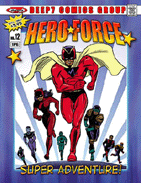
|
About OgreCave and its staff
|

|
by Demian Katz
While Deep7 covered most of the obvious genres right away when they introduced their 1PG line of fast-playing cinematic roleplaying games, it took them a few years to get around to creating a superhero system. Fortunately for fans of the genre, they got around to it with Hero Force, and it’s now possible to perform astounding acts of heroism with only minimal preparation. In fact, things are simple enough that you can even play a headliner and sidekick team if you so desire!
A Call for Heroes 1PG RPGs always include background tables to randomly assign traits to characters, and Hero Force is no exception. One of the tables here actually assigns what kind of hero the character is: a Blaster, who uses energy blasts to injure or stun; a Mentalist, who relies on telekinesis; an Elemental, with control over natural forces; a Mystic, with magical abilities; a Vigilante, armed with modern equipment and righteous anger; or a Gadgeteer, with amazing scientific equipment and a power suit. Unfortunately, it is at this point that the game diverges most from the rest of the line. Players must choose powers to go with their hero type, and this portion of the game runs the risk of becoming both unbalanced and convoluted For some reason, the rules dictate that the BRAINS stat and the Control skill are always tied to superpowers. For most hero types, ability checks are made against BRAINS+Control, and for every hero type, this sum determines the extent of a character’s power. This is where balance problems are introduced. If a character’s concept (like, for example, a berserker strongman) has nothing to do with either BRAINS or Control, why should it be a weaker superhero for having low scores in those stats? It seems like it would have been wiser to allow players to negotiate with the referee to determine which Stat/Skill pair is truly relevant to an individual character’s abilities. The rules devote two whole pages to explaining how players can spend their Power Level Pool (the sum of BRAINS and Control) to purchase superpowers. The first of these pages speaks in very general terms about both universal powers available to all hero types and type-specific powers. It is here that character creation can become convoluted, as each player may need to negotiate individually with the referee to come up with a playable character. This could be a problem if everyone is in a hurry, and quick games are supposed to be the main objective of the 1PG line. This problem is largely made up for by the second page of power-related rules, which lists specific universal and type-specific powers, but there is still a weakness – the page completely leaves out Vigilantes. This is presumably by design rather than by accident, since Vigilantes use their Power Level Pool to buy equipment rather than powers, but it takes some flavor away from the game; it is unfortunate that a few outlandish weapons couldn’t have been included here along with everything else. Although the superhero rules presented here are far from perfect, their simplicity is a saving grace. It takes little effort to adjust which stats affect superpowers or, in a time crunch, to force players to pick pregenerated powers rather than arguing about how to create new ones. Perhaps more important are the scenarios included to support the system. Fortunately, Hero Force includes a good mix of styles which should include something that appeals to just about anyone. As with the rules, though, the scenarios show a bit more rules-oriented complexity than most 1PG titles; while most 1PG scenarios force the referee to fudge stats, four of the five adventures here offer detailed stat blocks for key figures. Referees who like such precision should appreciate this a great deal, and everyone else can safely ignore them. The first scenario, “Better Dead than Red!,” features an ultra-patriotic style of heroism. Unfortunately, it also happens to be the weakest scenario in the game, with repetitive fights, a poorly supported need for investigation, and an abrupt and illogical conclusion. Of course, these may well be appropriate to the genre, so it could work out just fine in spite of its flaws. The second scenario, “Trouble Down Below,” is more fleshed-out (and potentially darker) than the first, and it’s also more adaptable to different styles of superhero play. The third adventure, “This Earth Consumed!,” is the standout of the bunch, packing its single page with globetrotting adventure, alien threats, heroic sidetracks, and plenty of opportunity for combat, death-defying stunts and roleplaying. The fourth adventure, “Shades of the Past,” is less ambitious, but features the interesting novelty of being variable in length, with the referee having the option of ending things after one big fight or allowing a more drawn-out battle between heroes and villains to ensue. The game is wrapped up with “State of Emergency,” a cross-over with the Disaster! 1PG which has the heroes facing a (semi-)natural disaster instead of the usaul costumed villains. This scenario is almost like a mini-sourcebook, detailing the many dangers heroes would face in a catastrophic situation rather than dictating exactly what should happen; as a result, this should be of particular interest to flexible referees.
Conclusions
|
||||
 Hero Force: Super Adventure
Hero Force: Super Adventure